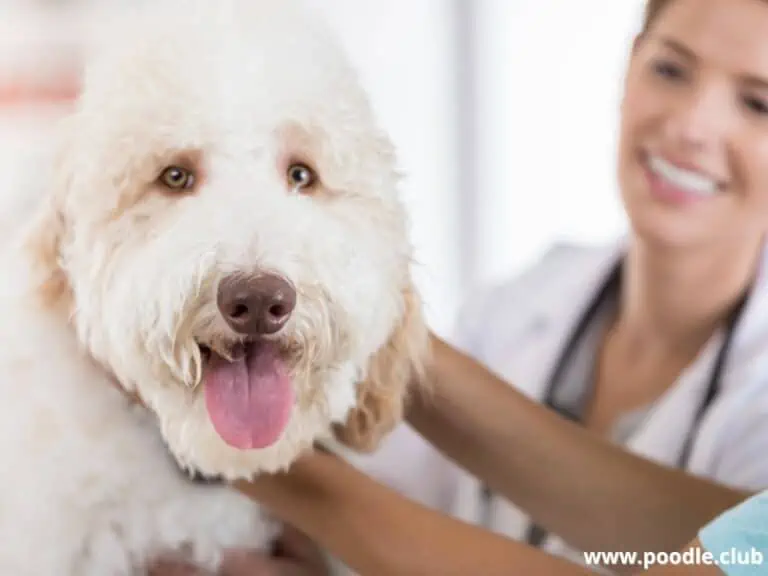When is a Labradoodle Fully Grown? Key Milestones and Growth Facts
When choosing a dog as a family pet or companion, one important consideration is its size and growth pattern, especially when it comes to breeds like Labradoodles. Labradoodles, a popular crossbreed between Labrador Retrievers and Poodles, are known for their friendly temperament and appealing appearance. However, as a hybrid breed, their size can vary significantly, which raises the question: when is a Labradoodle fully grown?
Understanding the growth and development of a Labradoodle involves recognizing the various factors that contribute to their final size and shape. These factors include the size and genes of their Poodle and Labrador parents and how the combination influences their offspring. Recognizing when a Labradoodle reaches its full size is essential for providing them with the proper care, living space, and exercise regimen necessary to ensure a happy, healthy life.

Key factors such as growth, development, health, and lifestyle play a significant role in determining when a Labradoodle becomes fully grown. By considering these elements and providing your Labradoodle with early care and socialization, you can ensure that your furry friend reaches their full potential and makes an excellent addition to your family.
Key Takeaways
- Labradoodles reach full growth through various factors, including parent genetics.
- Understanding growth and development helps provide proper care and exercise.
- Early care, socialization, and health considerations contribute to a well-rounded Labradoodle.
Understanding Labradoodle Sizes
When considering a Labradoodle, it’s important to understand the different sizes available: Standard Labradoodle, Medium Labradoodle, and Mini Labradoodle. Each size category is determined by their parent breed, either a Labrador Retriever or a Poodle (Standard, Miniature, or Toy). Let’s take a closer look at each size variation.

Standard Labradoodle
The Standard Labradoodle is the largest of the Labradoodle sizes. Typically achieved by crossing a Labrador Retriever with a Standard Poodle, these dogs can weigh anywhere from 50 to 65 pounds and have a height range of 22 to 26 inches. Standard Labradoodles are known for their friendly and energetic temperament, making them great family pets.
Since they are a larger breed, it’s important to ensure they have a healthy diet and regular exercise to maintain a healthy lifestyle.
Medium Labradoodle
The Medium Labradoodle is a happy medium between the Standard and Mini Labradoodle. This size is usually achieved by crossing a Labrador Retriever with a Miniature Poodle. The Medium Labradoodle weighs between 30 to 45 pounds and stands 18 to 21 inches tall.
Like their larger counterparts, Medium Labradoodles are affectionate and playful, making them excellent companions for families. They, too, require a balanced diet and a regular exercise routine to stay fit and healthy.
Mini Labradoodle
The smallest of the Labradoodle sizes is the Mini Labradoodle. A result of crossing a Labrador with a Toy or Miniature Poodle, these dogs typically weigh between 15 to 25 pounds and have a height range of 14 to 17 inches. Mini Labradoodles possess the same friendly and outgoing temperament as the other sizes, making them ideal for families with limited space.
Despite their smaller size, Mini Labradoodles still need a nutritious diet and regular exercise to maintain their wellbeing.
Labradoodle Growth and Development

Puppy Stage
Your Labradoodle puppy will experience rapid growth during the first few months. Genetics from both the Labrador Retriever and Poodle parents play a significant role in determining their growth patterns. Mini Labradoodles tend to reach their full adult height earlier than medium or standard-sized Labradoodles.
PuppySpot is a reputable dog marketplace where you can browse and find compatible puppies right from the comfort of your home. They have placed over 200,000 puppies into homes in the US!
During this stage, it is essential to provide your puppy with a balanced diet to support their growth and development. It is vital to monitor their weight using a Labradoodle weight chart to ensure they are growing at a healthy pace. Puppy growth milestones include:
- Weight: Mini Labradoodles will typically weigh between 15 to 25 pounds, while Medium Labradoodles can range from 30 to 45 pounds.
- Age: By 5 to 6 months old, your Labradoodle puppy may have reached about 75% of its adult height.
Adolescent Stage
The adolescent stage for a Labradoodle usually occurs between 6 months to 2 years. During this period, your Labradoodle will continue to grow in height and weight, but at a slower pace than the puppy stage. Bones and joints are still developing, which can cause some awkwardness in their movements.
As your Labradoodle gets older, it is essential to monitor their diet and exercise to reduce the chances of developing joint issues, such as elbow dysplasia. Key aspects of this stage include:
- Height: Your Labradoodle’s height will still be increasing, but they should be close to their adult height by 12 months.
- Developmental milestones: Watch for increased confidence and independence, as well as the development of their adult coat.
Adult Stage
Labradoodles reach their full-grown size around 12 to 24 months, depending on their genetics and individual variations. However, they may not be considered fully mature until around 3 years old.
During this stage, your Labradoodle’s growth will primarily be in muscle development and weight gain. They will also reach their full adult height, which varies depending on their size:
| Size | Adult Height Range |
|---|---|
| Mini | 14 to 16 inches |
| Medium | 18 to 20 inches |
| Standard | 22 to 24 inches |
By this stage, it’s important to provide your Labradoodle with a stable and consistent diet to maintain a healthy weight and support overall well-being. When in doubt, always consult your veterinarian for advice on your Labradoodle’s specific growth and development needs.
Health and Lifestyle Considerations
When raising your Labradoodle, it’s essential to consider key aspects of their health and lifestyle. A balanced lifestyle is crucial to ensure their happiness and well-being. Pay attention to aspects such as vet visits, food and exercise, making sure you fulfill their needs.

Regular visits to the veterinarian are necessary for the health of your Labradoodle. These checkups can help detect health issues early, such as hip dysplasia or joint disorders. Work with your veterinarian to create a vaccination and preventive care plan tailored to your dog’s specific needs.
An essential factor in your Labradoodle’s well-being is providing proper nutrition. Ensure you’re feeding them quality dog food that meets their dietary needs and consult your veterinarian for recommendations. Be mindful of potential allergies, as some Labradoodles are hypoallergenic and may require a specific diet.
Exercise plays a vital role in your Labradoodle’s overall health. Depending on the size of your dog, they may need different levels of physical activity. Even if you live in an apartment, make sure to engage them in regular walks, playtime, and mental stimulation exercises.
However, if you have a yard, your Labradoodle can benefit from ample space to run and play.
Training your Labradoodle is essential for their happiness and well-being. Start with basic obedience training and consider enrolling them in a professional dog training course. Be consistent with potty training and crate training to avoid any behavioral issues.
Providing them with chew toys is an excellent way to keep them entertained and reduce stress.
Socialization is also an important aspect of your Labradoodle’s lifestyle. Expose them to various people, children, and other pets to create a well-rounded and sociable dog. This exposure is necessary for Labradoodles serving as guide dogs or therapy animals.
Investing in pet insurance is a wise decision, as it can cover unexpected health mishaps and provide peace of mind. It’s also important to keep your Labradoodle’s health in check through regular DNA testing. This test helps identify inherited conditions and allows you to make informed decisions about their care.
In summary, to raise a happy, healthy Labradoodle, prioritize regular vet visits, provide a proper diet and exercise, offer consistent training, and socialize your pet. By addressing these factors in their upbringing, your Labradoodle will thrive and develop into a well-rounded companion.
Early Care and Socialization
During the early stages of your Labradoodle’s growth, it is essential to prioritize early care and socialization. As a mix between a Poodle and a Labrador Retriever, Labradoodles inherit traits from both breeds. Medium Labradoodles, for instance, may take after the Australian Labradoodle, English Cocker Spaniel, or Cocker Spaniel in terms of size and temperament.

When your Labradoodle is still a puppy, they will experience teething, just like human infants. To ease the discomfort their adult teeth may cause, provide them with safe and appropriate chew toys. By the time your Labradoodle reaches six months, they should have a full set of adult teeth.
It is beneficial for your Labradoodle to be spayed or neutered as part of their early care regimen. The Kennel Club generally recommends spaying or neutering between four and six months old. It is essential to consult your veterinarian, as the optimal timing for spaying or neutering can vary based on individual factors.
Early socialization is crucial for a well-rounded and adaptable Labradoodle. Expose your puppy to various people, animals, and environments to instill confidence and a sociable demeanor. Enroll them in puppy socializing classes, where they can interact with other puppies and receive guidance from professional trainers.
At around 10 to 12 months, you can start transitioning your Labradoodle from puppy food to adult food. Introduce the new food gradually to their diet, as this helps prevent digestive issues. The transition should be complete within one to two weeks.
Being confident, knowledgeable, and neutral will help you provide your Labradoodle with the proper care and socialization to ensure they develop into a well-behaved, healthy family member.
Choosing the Right Labradoodle
When looking for a Labradoodle, it’s essential to consider the size and weight that best suits your lifestyle and living situation. Labradoodles come in three main sizes: standard, medium, and miniature. The weight of a fully grown Labradoodle can range from 15 pounds (7 kg) for the smallest to 70 pounds (30 kg) for the largest.

As a mix of Labrador and Poodle breeds, Labradoodles inherit traits from both parents. Their friendly, smart, affectionate, and playful nature contributes to their popularity. When choosing a Labradoodle, the Poodle’s size from which it has been bred (Standard, Miniature, or Toy) will significantly influence its size.
Medium Labradoodles stand around 18-20 inches (45-50 cm) at the withers, while standard Labradoodles can be 22-24 inches (55-60 cm) tall. Regardless of size, they all carry common health risks like hip dysplasia and certain cancers. It is crucial to find a reputable breeder who can provide detailed health records for both Poodle and Labrador parent breeds.
To narrow down your options, consider the following points:
- Weight: Visualize the ideal weight of your future pet, which will help determine the Labradoodle size best suited for you.
- Breed: Analyze your preferences and needs to choose between the three main sizes of Labradoodles.
- Temperament: Keep in mind that Labradoodles are generally friendly, smart, affectionate, and playful.
Finding a trustworthy breeder is essential to ensure that you bring home a healthy and happy Labradoodle. A reputable breeder will provide you with the necessary health clearances and relevant health information. Also, they often allow you to visit their facility, meet the parent breeds, and ensure that their breeding practices prioritize the dogs’ well-being.
Remember, selecting the right Labradoodle requires research on your part, as well as open communication with the breeder. This will help ensure that you welcome a loving and compatible companion into your home.



![Why Is My Dog Sleeping With Its Tongue Out? [Is it OK?]](https://poodle.club/wp-content/uploads/2023/01/dog-sleeping-with-tongue-out-pc-768x512.webp)

